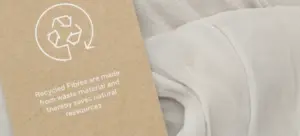The environmental impact of the fashion industry has been at the centre of global discussions in recent years. As brands seek more sustainable solutions, one often overlooked but highly relevant aspect is the role clothing labels play in recyclability. Despite their small size, labels can significantly affect a garment’s ability to be recycled. So, how exactly do they influence this, and what steps are being taken to minimise their ecological footprint?
What do we do with our clothes at the end of their lifespan?
Sustainable fashion isn’t just about creating long-lasting garments; it’s also about ensuring that those garments can be reintegrated into the production cycle once they’ve served their purpose. Garment recyclability is crucial in preventing items from ending up in landfills, and every component of a garment, including the label, plays a role in this process. While much attention has been given to textiles, labels—often made from non-recyclable materials—can impede the efficient recycling of garments.
The role of labels in recyclability
Labels carry essential information such as size, care instructions, and branding. However, they’re often made from materials that are incompatible with textile recycling processes. As a result, when left on a garment at the end of its lifecycle, non-recyclable labels can compromise the recycling process, potentially leading to the garment being discarded altogether.
How labels affect the recyclability of garnments
The key factor here is the type of materials used to make the labels and their environmental impact. Labels can be made from a variety of materials, including polyester and cotton, each of which has a different effect on the recycling process.
For instance, polyester labels are durable but don’t decompose easily, making them a barrier to recycling. Cotton labels, on the other hand, are more compatible with cotton garment recycling. This is why at Indet, we recommend choosing label materials based on both the sustainability of the material itself and its compatibility with the main fabric of the garment.
One of the biggest challenges is that labels made from synthetic materials are not easily separable from the garment. This means that when garments reach recycling plants, the label can contaminate the process, making the garment less suitable for recycling or for breaking down into new textile materials. Even when adhesive labels are used, if the adhesive isn’t biodegradable or recyclable, it remains a problem.
Furthermore, some labels are dyed or printed with non-recyclable inks, adding another layer of complication to the process.
Advances in biodegradable and recyclable materials for labels
Fortunately, we now have more sustainable solutions for garment labelling. Biodegradable materials, such as recycled paper or bio-based plastics, are gaining popularity. In addition, natural inks and water-soluble adhesives are increasingly being used, allowing labels to dissolve or degrade during the recycling process without compromising the garment.
Another significant advancement is the use of digital labels. These labels, accessible via RFID technology, enable brands to provide the same amount of information without the physical impact of a traditional label. This not only enhances recyclability but also reduces material usage overall.
Global initiatives for greener labelling standards
Globally, various organisations are working to establish standards that promote the use of sustainable labels. The European Union, for example, has begun enforcing regulations like the recent Ecodesign for Sustainable Products Regulation, which requires that clothing labels be biodegradable or easily recyclable.
Moreover, initiatives like The Fashion Pact are bringing together leading brands to adopt more eco-friendly practices, including the use of sustainable labels. These policies address not only the material of the labels but also the clarity and simplicity of the information provided, reducing the need for multiple labels on a single garment.
Economic and environmental benefits of adopting sustainable labels
Adopting sustainable labels not only benefits the environment but also has a positive impact on brands’ businesses. Eco-friendly labels can reduce costs in the long run, as more efficient recycling processes make it easier and less expensive to reuse textiles. Additionally, consumers are becoming increasingly aware of the impact of their purchasing choices, and brands that embrace sustainable labels can attract the attention of this growing segment.
Sustainable labels can also serve as a key differentiator for brands looking to appeal to environmentally conscious consumers. By highlighting the use of recyclable or biodegradable labels, brands can reinforce their commitment to sustainability and foster greater customer loyalty. Ultimately, these labels can educate consumers on how to recycle garments properly at the end of their life, thereby closing the loop on sustainable fashion.
The impact of labels on the recyclability of garments is an aspect that, although it may not seem highly significant at first glance, plays a crucial role in sustainable fashion. Non-recyclable materials used in labels can compromise garment recycling efforts.
Fortunately, biodegradable materials and digital labels offer an excellent and increasingly widespread alternative, giving brands the opportunity to move towards a more circular fashion model. At the same time, consumers can make more informed choices by selecting garments from brands that are committed to sustainability in every aspect, including their labels.



